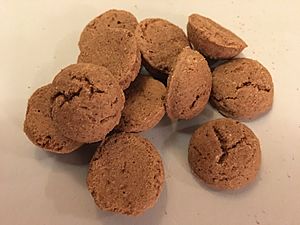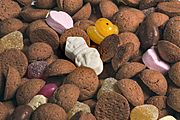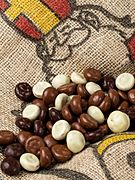Kruidnoten facts for kids

kruidnoten
|
|
| Alternative names | kruidennoten (mistakenly), pepernoten (mistakenly) |
|---|---|
| Type | Biscuit |
| Place of origin | Netherlands |
| Main ingredients | |
| Variations | many (see article) |
| 75 or more kcal | |
Kruidnoten (which sounds like "krowt-noh-ten") are small, hard, cookie-like treats from the Netherlands. They are about the size of a coin and look a bit like tiny hamburger buns. These yummy cookies are made with special spices, similar to speculaas. They are a big part of the traditional Sinterklaas celebrations in Belgium and the Netherlands.
Contents
Sinterklaas Traditions
In the Netherlands
During the Sinterklaas season, especially when Sinterklaas arrives, children often receive handfuls of kruidnoten from his helpers. At home, on Sinterklaas eve, kruidnoten and other candies are sometimes thrown around. Children love to collect these dropped treats.
In the past, it was common to throw kruidnoten on the ground at schools when Sinterklaas visited. Nowadays, Sinterklaas's helpers usually place a small pile or bag of kruidnoten directly on a student's desk or in their hand. This tradition of giving out kruidnoten is a symbol of Sinterklaas's kindness and generosity.
Some schools and supermarkets even let children make their own kruidnoten! They give kids pre-made dough to shape into the cookies.
In Belgium
For a long time, people in Flanders (part of Belgium) did not eat kruidnoten. There were no special traditions for them there. However, around the late 2010s, more people in Belgium started to enjoy them. Instead of kruidnoten, Sinterklaas's helpers in Belgium often give out letter-shaped biscuits. These biscuits have different names depending on the area, like "karolientjes" or "nicnacjes."
Many Flavors of Kruidnoten
Kruidnoten are one of the most popular candies during the Sinterklaas time in the Netherlands. In recent years, people have started to experiment a lot with the traditional recipe.
You can now find special pop-up shops that sell only kruidnoten with many different flavors. Even regular grocery stores and candy shops offer a good selection. Besides the classic spiced kruidnoten, you can find them covered in different kinds of chocolate, like white, milk, or dark chocolate.
Big stores and producers offer many unique flavors. Here are some of the interesting ones you might find:
- Caramel (often with sea salt)
- Coconut
- Butterscotch
- Tiramisu
- Crème brûlée
- Stracciatella (like chocolate chip ice cream)
- Yogurt
- Stroopwafel
- Tompouce (a Dutch pastry)
- Macaroon
- Speculoos (a milder, softer cookie)
- Liquorice
- Salmiak (salty liquorice)
- Ginger
- Cinnamon
- Hazelnut
- Pistachio
- Anise
- Peanut butter
- Toffee
- Honey
- Cheese
- Bubblegum
- Cola
- "Rainbow/Unicorn" (colorful, sugar-coated kruidnoten)
- Fruit flavors like:
- Strawberry
- Blueberry
- Raspberry
- Orange
- Banana
- Lemon
- Coffee flavors like:
- Cappuccino
- Irish coffee
- Cake and pie flavors like:
Gallery
Fun Facts
- Sometimes, food companies or groups that represent consumers hold contests. They ask people to suggest new flavors for kruidnoten or vote for their favorites.
- Even though they are different, some people in the Netherlands mistakenly call kruidnoten "pepernoten." Stores might even list them under that name sometimes!
See also
 In Spanish: Kruidnoten para niños
In Spanish: Kruidnoten para niños



